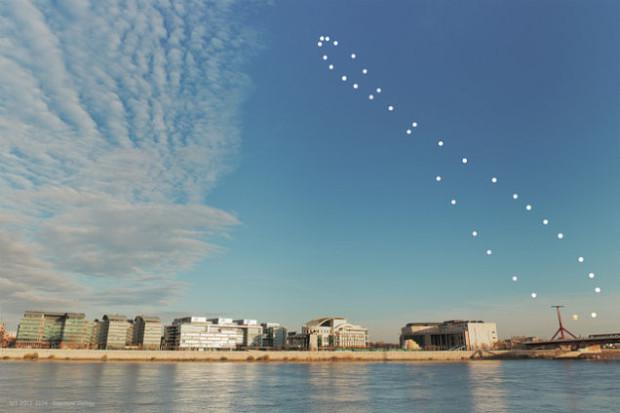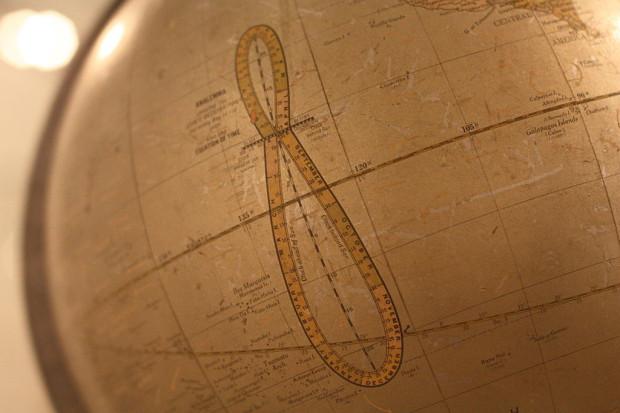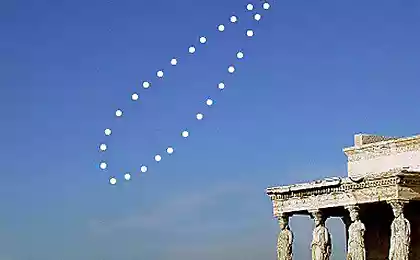571
What is the analemma, and why Sun does not coincide with the clock
About antique globes and mysterious vosmёrkah
When you were in elementary school, you'll probably ever look at the old Globe, which was invented long before Google Earth. Watch and wonder: what is this strange figure of eights is visible on the side of the globe? Your teacher probably had no idea what it is. And you've probably got an answer from him like: "This calendar».

This mysterious figure eight actually called analemma, and it tracks the movement of the sun across the sky during the year. In general, the measurement of time - it is not always the measurement of moving forward, as we all think. Our modern calendar and the clock is none other than the types of compromise: we are in a constant battle for synchronizing these devices with the heavens.
Throughout human history, the daily period of time determined by the movement of the sun. Noon is when the Sun reaches its highest point above the local horizon, crossing the north or south meridian. The problem is that the passage of the sun across the sky does not always correspond to the time of one revolution of the Earth around its axis, that is, it does not coincide with 24 hours. In October, the sun reaches its highest point above the horizon for 16 minutes early in February at 12 minutes later.
And why is that annoying Universe does not want to remain constant?
And there is such a discrepancy due to two important factors: because of the elliptical orbit of the Earth, and because of the particular angle at which the axis of the planet is inclined to the ecliptic. Of these two factors, the primary role is played by the axial tilt of the planet, and the elliptic orbit is in the background. If Earth's orbit is a perfect circle, and its axis would always be strictly perpendicular to the orbital plane, it would be observed no seasonal differences in time. That's just not one of the planets known to science is not in such ideal conditions.
Can you build your own analemma? Yes, you can do it simply by fixing the daily position of the sun in the sky at the same time. During this procedure, it is important not to forget about the transition to winter time and back (if you live where there is still observed, this archaic practice). And to start this project is best in the winter, in December solstice day, as on this day the midday sun passes the lowest point on the horizon.
via factroom.ru

When you were in elementary school, you'll probably ever look at the old Globe, which was invented long before Google Earth. Watch and wonder: what is this strange figure of eights is visible on the side of the globe? Your teacher probably had no idea what it is. And you've probably got an answer from him like: "This calendar».

This mysterious figure eight actually called analemma, and it tracks the movement of the sun across the sky during the year. In general, the measurement of time - it is not always the measurement of moving forward, as we all think. Our modern calendar and the clock is none other than the types of compromise: we are in a constant battle for synchronizing these devices with the heavens.
Throughout human history, the daily period of time determined by the movement of the sun. Noon is when the Sun reaches its highest point above the local horizon, crossing the north or south meridian. The problem is that the passage of the sun across the sky does not always correspond to the time of one revolution of the Earth around its axis, that is, it does not coincide with 24 hours. In October, the sun reaches its highest point above the horizon for 16 minutes early in February at 12 minutes later.
And why is that annoying Universe does not want to remain constant?
And there is such a discrepancy due to two important factors: because of the elliptical orbit of the Earth, and because of the particular angle at which the axis of the planet is inclined to the ecliptic. Of these two factors, the primary role is played by the axial tilt of the planet, and the elliptic orbit is in the background. If Earth's orbit is a perfect circle, and its axis would always be strictly perpendicular to the orbital plane, it would be observed no seasonal differences in time. That's just not one of the planets known to science is not in such ideal conditions.
Can you build your own analemma? Yes, you can do it simply by fixing the daily position of the sun in the sky at the same time. During this procedure, it is important not to forget about the transition to winter time and back (if you live where there is still observed, this archaic practice). And to start this project is best in the winter, in December solstice day, as on this day the midday sun passes the lowest point on the horizon.
via factroom.ru
Unlike most places in the world, in Algeria women successful men
10 new technologies invading the personal space























